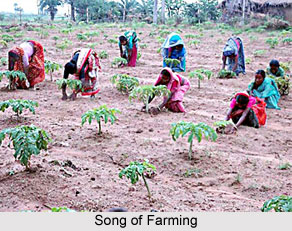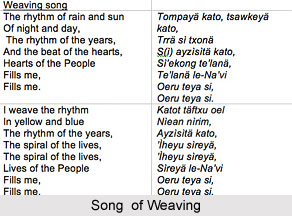 Work and festive songs reflect the socio-economic aspects of life of the rural folk. Some of them sing of productive relationships in society and of the instruments of production. Most of the folksongs in fact arose and developed in direct connection with the labouring processes. These songs throw light on the socio-economic life of the people. Most of the people in the rural areas are peasants, mainly the tillers of soil. Most of their other occupations, besides agriculture, are of a subsidiary nature. And these songs are fitted into the usual agricultural pattern of economy. Thus, there have grown a rich variety of songs - songs of the paddy-field, of the cowherds, fishermen, boatmen, basket-makers, village-smiths, etc. The agrarian economy of the village is the principal feature of these songs.
Work and festive songs reflect the socio-economic aspects of life of the rural folk. Some of them sing of productive relationships in society and of the instruments of production. Most of the folksongs in fact arose and developed in direct connection with the labouring processes. These songs throw light on the socio-economic life of the people. Most of the people in the rural areas are peasants, mainly the tillers of soil. Most of their other occupations, besides agriculture, are of a subsidiary nature. And these songs are fitted into the usual agricultural pattern of economy. Thus, there have grown a rich variety of songs - songs of the paddy-field, of the cowherds, fishermen, boatmen, basket-makers, village-smiths, etc. The agrarian economy of the village is the principal feature of these songs.
Songs on Farming
The blessings of nature are necessary for good harvests. However, there are forces of nature that often destroy cultivation and life. The people sing of them in song. They sing with all their heart and mind and energy too as the songs sustain them; the tedium of work is relieved through songs. The Pullayas of Kerala have a kind of paddy-transplantation songs. These songs are sung in chorus; a woman or a girl leads the song and others join her. Likewise, in the harvesting field, the Assamese woman, as she is engaged in reaping the corn, sings.
With the coming of spring, the peasant`s mind turns towards thoughts of cultivation- good harvest, fruitfulness and satisfaction. By representing the aspects of agriculture in songs and dances, the peasant thought that it could be possible to produce an influence on the field, and cattle-stock too. These songs are invariably of a lyrical and melancholy character.
Songs on Instruments of production
The instruments of production have also inspired folk songs. There are loving references to them in some of the peasant-lyrics. In ancient peasant-Kussia, they used to carry about the plough in a ceremonial ritual. Such customs of veneration obtain in almost all peasant-societies. There are songs on the bullock-cart motif too. The burden of these songs generally is the different aspects of agricultural activity, viz., cultivation, harvesting, threshing, etc. Besides them, other activities like weaving, spinning, rearing cattle, fishing etc., also come within the purview of these songs.
The cow is a very important unit of the rural economy. The Ahirs or cowherds are an important functional group. Bihar and Uttar Pradesh are considerably rich in songs of cowherds. These songs are known as Biraha songs. They embrace a wide avenue of social and individual experience.
 Songs on Weaving
Songs on Weaving
In Kashmir and Punjab, there are songs that are concerned with the process of weaving. There is an abundance of spinning-wheel songs in Punjab. Women have their spinning-bee called Trinjan; girls, young brides, and women of all ages sit in a group and spin. This community spinning gives rise to community singing.
Songs on Fishing
Fishermen are a class apart. They have their own songs. There are other classes of people, who catch fish as an occasional pastime. These people usually indulge in community fishing. The professional fishermen of Madhya Pradesh called kewats have given a good number of typical fishing-songs. These songs are not about fish as such. They seek to give a glimpse into the inner life of the fish also. Their destiny is not certain as the fishermen`s hook and net create disaster for them.
Songs on Craft and labour
The Gond and the Pardhan have some fine songs of craft and labour, particularly around the husking of rice and millet. The rice-husker, the winnowing-fan, the rice-pounder- these implements claim their special devotion and affection. There is always something of magic in the winnowing-fan, according to folk-belief. The Gunias, of the Maikal Hills, use it for divination.
Festive Folk Songs
The Gidha dance-songs are mostly love-songs. They are often naked and vulgar and show signs of physical exuberance. On the other hand, the songs connected with the Holi festival are of a religious import. Mythological allusions are interspersed with these songs. With respect to the Holi festival, the emphasis of the Adivasis is neither spiritual nor religious. It is to them a popular festival of riotous joy and gay abandon. It is celebrated with a bonfire and it is believed that Havana`s corpse is burnt in it. Some of their Holi or Phag Songs are rather crude. The Durga Puja is a popular festival of Bengal. Its symbolism is deep and intense. It is the aspect of the home-coming of a daughter to her mother, after a year in her husband`s home that captures the folk-mind. This has given rise to a body of songs known as Agamani songs i.e. songs of welcome.




















